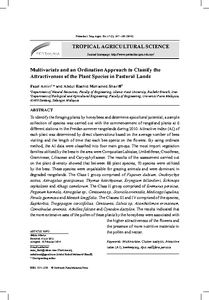Citation
Amiri, Fazel and Mohamed Shariff, Abdul Rashid
(2014)
Multivariate and an ordination approach to classify the
attractiveness of the plant species in pastoral lands.
Pertanika Journal of Tropical Agricultural Science, 37 (3).
pp. 347-362.
ISSN 1511-3701; ESSN: 2231-8542
Abstract
To identify the foraging plants by honeybees and determine apicultural potential, a sample collection of species was carried out with the commencement of rangeland plants at 6 different stations in the Freidan summer rangelands during 2010. Attractive index (AI) of each plant was determined by direct observations based on the average number of bees visiting and the length of time that each bee spents on the flowers. By using ordinate method, the AI data were classified into four main groups. The most import vegetation families utilized by the bees in the area were Compositae Labiatae, Umbeliferae, Cruciferae, Gramineae, Liliaceae and Caryophyllaceae. The results of the assessment carried out on the plant diversity showed that between 88 plant species, 70 species were utilized by the bees. These species were unpalatable for grazing animals and were dominant in degraded rangelands. The Class I group comprised of Papaver dubium, Onobrychys sativa, Astragalus gossipianus, Thymus kotschyanus, Eryngium billardieri, Echinops cephalotes and Alhagi camelorum. The Class II group comprised of Eremurus persicus, Peganum harmala, Astragalus sp., Centaurea sp., Scariola orientalis, Medicago lupulina, Ferula gummosa and Mentah longifolia. The Classes III and IV comprised of the species, Euphorbia, Tragopagon caricifolius, Centaurea, Salvia sp, Acantholimon erinaceum, Convolvulus arvensis, Achillea falcate and Cynodon dactylon. The results indicated that the more extensive uses of the pollen of these plants by the honeybees were associated with the higher attractiveness of the flowers and the presence of more nutritive materials in the pollen and nectar.
Download File
![[img]](http://psasir.upm.edu.my/24657/1.hassmallThumbnailVersion/Multivariate%20and%20an%20ordination%20approach%20to%20classify%20the%20attractiveness%20of%20the%20plant%20species%20in%20pastoral%20lands.pdf)  Preview |
|
PDF
Multivariate and an ordination approach to classify the attractiveness of the plant species in pastoral lands.pdf
Download (747kB)
| Preview
|
|
Additional Metadata
Actions (login required)
 |
View Item |

